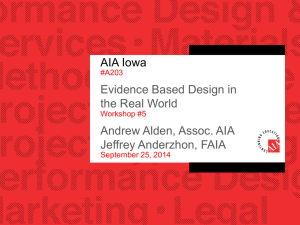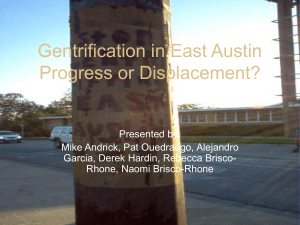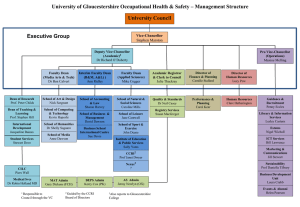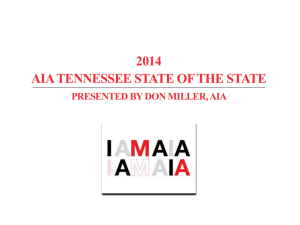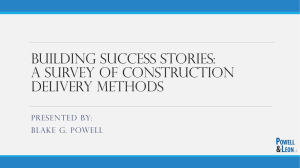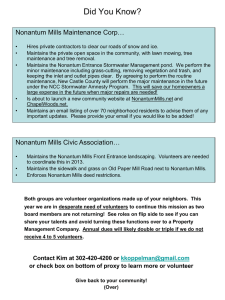Leahy-Smith America Invents Act Some Prosecution and Litigation
advertisement
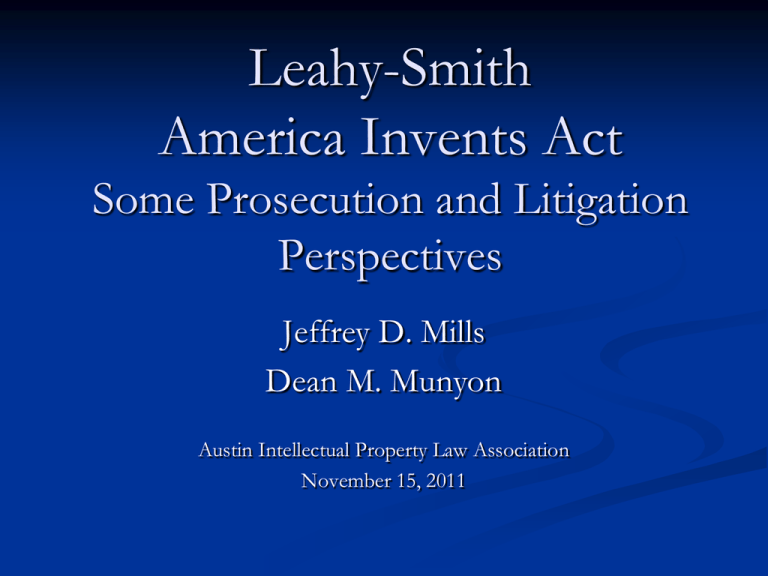
Leahy-Smith America Invents Act Some Prosecution and Litigation Perspectives Jeffrey D. Mills Dean M. Munyon Austin Intellectual Property Law Association November 15, 2011 Overview Changes to Sections 102 and 103 Post-Grant Procedures Litigation-Related Topics Jeffrey D. Mills and Dean Munyon - AIA Presentation -- Austin IPLA -- November 15, 2011 How To Vote Via Texting Standard texting rates only (worst case US $0.20) We have no access to your phone number Jeffrey D. Mills and Dean Munyon - AIA Presentation -- Austin IPLA -- November 15, 2011 How To Vote Via Poll4.com Jeffrey D. Mills and Dean Munyon - AIA Presentation -- Austin IPLA -- November 15, 2011 How To Vote via Twitter Since @poll is the first word, your followers will not receive this tweet Jeffrey D. Mills and Dean Munyon - AIA Presentation -- Austin IPLA -- November 15, 2011 What is your favorite color? Red 342428 Blue 342429 Green 342430 Yellow 342431 Other 342432 Changes to 102 and 103 Sec. 3 of AIA Section 102 rewritten First-to-file Invention date no longer relevant inquiry No more Rule 131 declarations Interferences eliminated 35 USC 102(g), 104 repealed Grace Period Uncertainty Jeffrey D. Mills and Dean Munyon - AIA Presentation -- Austin IPLA -- November 15, 2011 “Effective Filing Date” (EFD) Changes apply to applications with claims having “effective filing date” on or after March 16, 2013. EFD of claimed invention is either: Date of Priority Claim (e.g., filing date of parent application that discloses claimed invention); or Actual Filing Date. Defined in Sec. 100(i) for “claimed invention.” Defined in Sec. 102(d) (“effectively filed”) for patent/application prior art under 102(a)(2). Jeffrey D. Mills and Dean Munyon - AIA Presentation -- Austin IPLA -- November 15, 2011 Section 100(i): EFD for Claimed Invention (i)(1) The term “effective filing date” for a claimed invention in a patent or application for patent means– (A) if subparagraph (B) does not apply, the actual filing date of the patent or the application for the patent containing a claim to the invention; or (B) the filing date of the earliest application for which the patent or application is entitled, as to such invention, to a right of priority under section 119, 365(a), or 365(b) or to the benefit of an earlier filing date under section 120, 121, or 365(c). Jeffrey D. Mills and Dean Munyon - AIA Presentation -- Austin IPLA -- November 15, 2011 Question 1 Which of the following does the AIA change the most from a prior art perspective? (A) German national application with PCT application published in English and designating U.S. 341366 (B) Offer for sale in Canada 341367 (C) Japanese national application with no international or U.S. application 341368 (D) Publication by inventor within 1 year of filing 341369 Jeffrey D. Mills and Dean Munyon - AIA Presentation -- Austin IPLA -- November 15, 2011 Two Classes of Prior Art under 35 USC 102 Section 102(a)(1): Certain events before EFD of claimed invention. Has features similar to former sections 102(a), (b), and (d). Subject to exceptions in Section 102(b)(1). Section 102(a)(2): Patent/Application Prior Art. Has features similar to former section 102(e). Subject to exceptions in Section 102(b)(2). Jeffrey D. Mills and Dean Munyon - AIA Presentation -- Austin IPLA -- November 15, 2011 35 USC 102(a)(1) Claimed invention is not novel if: Patented Described in Printed Publication In Public Use On Sale Otherwise Available to Public before the EFD. Section 102(b)(1) lists certain exceptions. Jeffrey D. Mills and Dean Munyon - AIA Presentation -- Austin IPLA -- November 15, 2011 35 USC 102(a)(1) (a) Novelty; Prior Art- A person shall be entitled to a patent unless-(1) the claimed invention was patented, described in a printed publication, or in public use, on sale, or otherwise available to the public before the effective filing date of the claimed invention…. Jeffrey D. Mills and Dean Munyon - AIA Presentation -- Austin IPLA -- November 15, 2011 35 USC 102(a)(1): Catchall provision The phrase “otherwise available to the public” apparently means something other than patented, described in a printed publication, in public use, or on sale, but is not defined. What else does it cover? Publicly known information from former 102(a)? Gaps as to whether something would be considered a “printed publication”? Borderline public use cases? In isolation, “otherwise available to the public” could be read to suggest that the other enumerated events in 102(a)(1) also require public availability. Such a reading may be unlikely since prior case law did not have this requirement (e.g., secret commercial use). Jeffrey D. Mills and Dean Munyon - AIA Presentation -- Austin IPLA -- November 15, 2011 Effect of 35 USC 102(a)(1) 102(a)(1) is an expansion of available prior art: Public use and on sale activities outside U.S. now constitute prior art. Determination of prior art at EFD rather than date of invention, as in former 102(a). 102(a)(1) does not differentiate as to the “source” of the event (e.g., whether the “public use” was by the inventor or by another). Catchall provision increases what can be considered prior art, but by how much? Jeffrey D. Mills and Dean Munyon - AIA Presentation -- Austin IPLA -- November 15, 2011 Patent/Application Prior Art: 35 USC 102(a)(2) Claimed invention not novel if described in U.S. patent; U.S. published application; or International application designating the U.S. (“deemed published” application) that Names “another inventor”; and Is effectively filed (35 USC 102(d)) before the EFD of the claimed invention. Jeffrey D. Mills and Dean Munyon - AIA Presentation -- Austin IPLA -- November 15, 2011 35 USC 102(a)(2) (a) Novelty; Prior Art- A person shall be entitled to a patent unless-*** (2) the claimed invention was described in a patent issued under section 151, or in an application for patent published or deemed published under section 122(b), in which the patent or application, as the case may be, names another inventor and was effectively filed before the effective filing date of the claimed invention. Jeffrey D. Mills and Dean Munyon - AIA Presentation -- Austin IPLA -- November 15, 2011 35 USC 102(d) (d) Patents and Published Applications Effective as Prior Art- For purposes of determining whether a patent or application for patent is prior art to a claimed invention under subsection (a)(2), such patent or application shall be considered to have been effectively filed, with respect to any subject matter described in the patent or application-(1) if paragraph (2) does not apply, as of the actual filing date of the patent or the application for patent; or (2) if the patent or application for patent is entitled to claim a right of priority under section 119, 365(a), or 365(b), or to claim the benefit of an earlier filing date under section 120, 121, or 365(c), based upon 1 or more prior filed applications for patent, as of the filing date of the earliest such application that describes the subject matter. Jeffrey D. Mills and Dean Munyon - AIA Presentation -- Austin IPLA -- November 15, 2011 Hilmer Doctrine Abolished Previously, there were detailed rules about a reference’s effective date under 35 USC 102(e). See MPEP 706.02(f)(1). Under the Hilmer doctrine, for example, the 102(e) date of an application claiming priority to a foreign national application is its U.S. filing date. 1 year or less Inventive Entity #1 Inventive Entity #2 Japanese Application Filed U.S. Application Filed with Priority Claim Under 35 USC 119 U.S. Application Filed Jeffrey D. Mills and Dean Munyon - AIA Presentation -- Austin IPLA -- November 15, 2011 Publication Effective Date under former 102(e); application of Entity #1 is not prior art under 102(e) to application of Entity #2 Hilmer Doctrine Abolished Under the new law, a U.S. application claiming priority to a foreign application under 35 USC 119 can be considered to be effectively filed under 102(a)(2) as of the foreign filing date. 1 year or less Inventive Entity #1 Japanese Application Filed Inventive Entity #2 Effective Date under new 102(a)(2) U.S. Application Filed with Priority Claim Under 35 USC 119 U.S. Application Filed Publication Application of Entity #1 is 102(a)(2) prior art to that of Entity #2 Jeffrey D. Mills and Dean Munyon - AIA Presentation -- Austin IPLA -- November 15, 2011 Effect of 35 USC 102(a)(2) 102(a)(2) increases the scope of patent/application prior art by allowing certain patents/applications to have an earlier effective date (in addition to the scenario outlined in the preceding slides, 102(a)(2) also removes the requirement that international applications designating the U.S. must be published in English to be effective as prior art). 102(a)(2) does not draw in all patent-related prior art. For example, if there is a foreign national application, but no subsequent patented or published U.S. national application or an international application designating the U.S., 102(a)(2) does not appear to apply. Jeffrey D. Mills and Dean Munyon - AIA Presentation -- Austin IPLA -- November 15, 2011 35 USC 102(b) Disclosures: Exceptions to 102(a) Art 102(b)(1) provides exceptions to 102(a)(1) art; includes certain “disclosures” made a year or less before EFD of claimed invention. 102(b)(2) provides exceptions to 102(a)(2) art; includes certain “disclosures” appearing in patents and applications. Jeffrey D. Mills and Dean Munyon - AIA Presentation -- Austin IPLA -- November 15, 2011 35 USC 102(b)(1) Exceptions A “disclosure” 1 year or less before the EFD of a claimed invention is not prior art under 102(a)(1) if: Disclosure made by an inventor *: 102(b)(1)(A) The subject matter of the disclosure was previously publicly disclosed by an inventor *: 102(b)(1)(B) Previous public disclosure will be 102(a)(1) art unless 102(b)(1)(A) applies (public disclosure within a year of EFD of claimed invention). *Or another who obtained the subject matter disclosed from an inventor directly or indirectly Jeffrey D. Mills and Dean Munyon - AIA Presentation -- Austin IPLA -- November 15, 2011 35 USC 102(b)(1) (b) Exceptions(1) DISCLOSURES MADE 1 YEAR OR LESS BEFORE THE EFFECTIVE FILING DATE OF THE CLAIMED INVENTION- A disclosure made 1 year or less before the effective filing date of a claimed invention shall not be prior art to the claimed invention under subsection (a)(1) if-(A) the disclosure was made by the inventor or joint inventor or by another who obtained the subject matter disclosed directly or indirectly from the inventor or a joint inventor; or (B) the subject matter disclosed had, before such disclosure, been publicly disclosed by the inventor or a joint inventor or another who obtained the subject matter disclosed directly or indirectly from the inventor or a joint inventor. Jeffrey D. Mills and Dean Munyon - AIA Presentation -- Austin IPLA -- November 15, 2011 35 USC 102(b)(2) exceptions A disclosure in a patent/application is not prior art under 102(a)(2) if: The subject matter disclosed by was obtained directly or indirectly from an inventor: 102(b)(2)(A). The subject matter disclosed, before its EFD under 102(a)(2), was previously publicly disclosed by an inventor or another who obtained the subject matter disclosed from an inventor: 102(b)(2)(B). Disclosed subject matter and claimed invention commonly owned/subject to assignment not later than EFD: 102(b)(2)(C). Jeffrey D. Mills and Dean Munyon - AIA Presentation -- Austin IPLA -- November 15, 2011 35 USC 102(b)(2) (2) DISCLOSURES APPEARING IN APPLICATIONS AND PATENTS- A disclosure shall not be prior art to a claimed invention under subsection (a)(2) if-(A) the subject matter disclosed was obtained directly or indirectly from the inventor or a joint inventor; (B) the subject matter disclosed had, before such subject matter was effectively filed under subsection (a)(2), been publicly disclosed by the inventor or a joint inventor or another who obtained the subject matter disclosed directly or indirectly from the inventor or a joint inventor; or (C) the subject matter disclosed and the claimed invention, not later than the effective filing date of the claimed invention, were owned by the same person or subject to an obligation of assignment to the same person. Jeffrey D. Mills and Dean Munyon - AIA Presentation -- Austin IPLA -- November 15, 2011 Example of 102(b) Exceptions 1/1/15: A publishes paper describing X (public disclosure) 2/1/15: B publishes paper describing X (not obtained from A) 10/1/15: B files patent application describing X; application later publishes (B’s EFD) 12/1/15: A files application claiming X (A’s EFD) For B’s application: A’s paper is 102(a)(1) art; no 102(b)(1) exceptions apply B’s application will be rejected based on A’s paper For A’s application: A’s paper is 102(a)(1) art; exempted under 102(b)(1)(A) B’s paper is 102(a)(1) art; exempted under 102(b)(1)(B) B’s application is 102(a)(2) art; exempted under 102(b)(2)(B) A’s application will not be rejected based on its paper, B’s paper, or B’s application Jeffrey D. Mills and Dean Munyon - AIA Presentation -- Austin IPLA -- November 15, 2011 Example of 35 USC 102(b)(2)(C) Exception Scenario: Application #1: discloses X Application #2: commonly-owned, filed six months later with different inventive entity, claims X Previously, disclosure of X in application #1 would prevent patenting of X in application #2. Because of 102(b)(2)(C), application #1 is not prior art to application #2 under 102(a)(2). 102(c) extends this same protection to joint research agreements. These provisions may be beneficial to entities with large patent portfolios. Jeffrey D. Mills and Dean Munyon - AIA Presentation -- Austin IPLA -- November 15, 2011 Answer to Question 1 Which of the following does the AIA change the most from a prior art perspective? (a) German national application with PCT application published in English and designating U.S.-now prior art under 102(a)(2) and 102(d) as of German filing date. (b) Offer for sale in Canada-Under 35 USC 102(a)(1), now prior art where previously the offer for sale had to be in the U.S. (c) Japanese national application with no international or U.S. application-102(a)(2) does not apply if there is no corresponding U.S. or PCT application designating the U.S. (d) Publication by inventor within 1 year of filing-now prior art under 102(a)(1) but exempted under 102(b)(1)(A). Jeffrey D. Mills and Dean Munyon - AIA Presentation -- Austin IPLA -- November 15, 2011 “Disclosures” in 102(b) What is a “disclosure”? The answer affects the applicability of 102(b)(1) in the first instance, and thus the scope of the grace period. This term is not defined in the AIA. Jeffrey D. Mills and Dean Munyon - AIA Presentation -- Austin IPLA -- November 15, 2011 Interpretations of “Disclosures” Under 102(b)(1) One end of spectrum: “disclosures” include all listed events in 102(a)(1). Arguments that may favor this interpretation: Policy: continuation of established expectations Textual: inclusion of “publicly disclosed” in statute may imply broader reading of “disclosure” Would create grace period similar to existing grace period. Other end of spectrum: “disclosures” only include such activities as publications and public presentations, not public uses or sales. Arguments that may favor this interpretation: Legislative history Would create much more limited grace period. Jeffrey D. Mills and Dean Munyon - AIA Presentation -- Austin IPLA -- November 15, 2011 “Public Disclosures” Publications and public presentations are almost certainly examples of public disclosure under 102(b)(1)(B) and 102(b)(2)(B). Does the term include some public uses or sales? Public disclosures under 102 have the dual effect of: Creating prior art against other parties. Eliminating prior art of other parties as to the inventor. What is the scope of the first to publicly disclose protection provided by 102(b)(1)(B) and 102(b)(2)(B)? Jeffrey D. Mills and Dean Munyon - AIA Presentation -- Austin IPLA -- November 15, 2011 First-to-File Comments Currently have a de facto first-to-file system since interferences and Rule 131 declarations are rare. Continued emphasis on turnaround from receipt of disclosure to filing of application. Increased use of provisional filings in certain situations. Larger issues exist with scope of grace period. Jeffrey D. Mills and Dean Munyon - AIA Presentation -- Austin IPLA -- November 15, 2011 Grace Period Comments Great uncertainty in advising clients regarding grace period (e.g., whether public use and sale/offer for sale by inventor within 1 year of filing are exempted as “disclosures” under 102(b)(1)(A)). This uncertainty may require IDS of such pre-filing activities to PTO while law is clarified. These effects are magnified for smaller clients. Increased filings through March 15, 2013 to avoid new regime (e.g., on sale activity on March 1, 2013). Jeffrey D. Mills and Dean Munyon - AIA Presentation -- Austin IPLA -- November 15, 2011 35 USC 103 Under previous version of 35 USC 103, obviousness assessed “at the time the invention was made.” New 103 assesses obviousness as of the “effective filing date of the claimed invention.” Jeffrey D. Mills and Dean Munyon - AIA Presentation -- Austin IPLA -- November 15, 2011 35 USC 103 A patent for a claimed invention may not be obtained, notwithstanding that the claimed invention is not identically disclosed as set forth in section 102, if the differences between the claimed invention and the prior art are such that the claimed invention as a whole would have been obvious before the effective filing date of the claimed invention to a person having ordinary skill in the art to which the claimed invention pertains. Patentability shall not be negated by the manner in which the invention was made. Jeffrey D. Mills and Dean Munyon - AIA Presentation -- Austin IPLA -- November 15, 2011 Third-Party Prior Art Submissions Adds subsection (e) to 35 USC 122, allowing any party to submit printed prior art in a patent application. Submissions can be made beginning September 16, 2012, in any pending application as long as timing requirements of 122(e)(1)(A) and (B) are fulfilled. Unlike current 37 CFR 1.99, submission must “set forth a concise description of the asserted relevance of each submitted document.” Jeffrey D. Mills and Dean Munyon - AIA Presentation -- Austin IPLA -- November 15, 2011 35 USC 122(e) Submission Timing Submissions must be submitted before notice of allowance. Prior to notice of allowance, art submission can be submitted up to: 6 months after publication or Date of first rejection whichever comes later. Jeffrey D. Mills and Dean Munyon - AIA Presentation -- Austin IPLA -- November 15, 2011 35 USC 122(e) Submission Timing Examples Publication Office Action rejection Publication + 6 mos. Notice of allowance Last third-party submission date Publication Publication + 6 mos. Office Action rejection Notice of allowance Last third-party submission date Publication Notice of allowance Publication + 6 mos. Last third-party submission date Jeffrey D. Mills and Dean Munyon - AIA Presentation -- Austin IPLA -- November 15, 2011 Post-Grant Proceedings Supplemental Examination: AIA Sec. 12 Ex Parte Reexamination: AIA Sec 6(h) Inter Partes Reexamination: AIA Sec. 6(c) Inter Partes Review: AIA Sec. 6(a) Post-Grant Review: AIA Sec. 6(d) Transitional Post-Grant Review for Business Method Patents: AIA Sec. 18 Jeffrey D. Mills and Dean Munyon - AIA Presentation -- Austin IPLA -- November 15, 2011 Supplemental Examination Basis: Any information AIA: New (35 USC 257) Available on September 16, 2012 for any current or future patent. Standard: Substantial New Question (SNQ) of Patentability Availability: Any time after issuance Estoppel: None Jeffrey D. Mills and Dean Munyon - AIA Presentation -- Austin IPLA -- November 15, 2011 Supplemental Examination Provides basis for patent owner to request that the PTO “consider, reconsider, or correct information believed to be relevant” to a patent. 35 USC 257(a). Unlike patent owner-initiated ex parte reexamination, supplemental examination is not limited to patents and printed publications. For example, may be based on: Information relating to a potential on-sale bar Information relating to a pending application. Request for supplemental examination to be decided within 3 months; if substantial new question of patentability raised, ex parte reexamination ordered. 35 USC 257(a), (b). Jeffrey D. Mills and Dean Munyon - AIA Presentation -- Austin IPLA -- November 15, 2011 Effect of Supplemental Examination Patent will not be held unenforceable on the basis of information presented during a supplemental examination. 35 USC 257(c)(1). 35 USC 257(c)(2) lists exceptions to the above rule. For example, 257(c)(1) does not apply when a supplemental examination not completed by date a patent enforcement action is brought in the ITC or district court. Jeffrey D. Mills and Dean Munyon - AIA Presentation -- Austin IPLA -- November 15, 2011 Supplemental Examination and Litigation In view of Therasense materiality standard, potentially useful when: Prior art reference that does not meet “but for” materiality standard Potential affirmative misrepresentation made to PTO that would not impact issuance of patent claims (may be material even though “but for” standard not met). Jeffrey D. Mills and Dean Munyon - AIA Presentation -- Austin IPLA -- November 15, 2011 Ex Parte Reexamination Basis: Printed Patents and Publications AIA: Removes option to seek district court review (effective September 16, 2011). Procedure is otherwise unchanged. Standard: Substantial New Question of Patentability (SNQ) Availability: Any time after issuance Estoppel: None Jeffrey D. Mills and Dean Munyon - AIA Presentation -- Austin IPLA -- November 15, 2011 Inter Partes Reexamination Basis: Printed Patents and Publications AIA: Eliminates inter partes reexamination as of September 16, 2012; standard for instituting changed in the interim Standard: Request filed prior to September 16, 2011-SNQ. Request filed between September 16, 2011 and September 15, 2012-Reasonable likelihood that the requester will prevail with respect to at least one of the claims challenged in the request. Availability: Any time after issuance Estoppel: In civil action, as to any ground that was raised or could have been raised in inter partes reexamination Jeffrey D. Mills and Dean Munyon - AIA Presentation -- Austin IPLA -- November 15, 2011 Question 2 Which of the following components of inter partes review and post-grant review are the same under the AIA? (a) Bases for invalidity challenges 341398 (b) Standard used by PTO in granting request for review 341399 (c) Timing of Request 341400 (d) Estoppel Standard 341401 (e) None of the above 341402 Jeffrey D. Mills and Dean Munyon - AIA Presentation -- Austin IPLA -- November 15, 2011 Inter Partes Review Basis: 102/103 Grounds Based on Printed Patents and Publications AIA: New (35 USC 311-319) Effective September 16, 2012 Standard: Reasonable likelihood that the requester will prevail with respect to at least one of the claims challenged in the request. Takes patent owner preliminary response into account. 35 USC 314(a). Availability-35 USC 311(c): After later of Expiration of 9-month period after grant/reissuance If PGR is instituted, at its termination. Also, must be filed within one year of being sued for infringement of the patent. Jeffrey D. Mills and Dean Munyon - AIA Presentation -- Austin IPLA -- November 15, 2011 Inter Partes Review Estoppel-35 USC 315(e): Attaches upon “final written decision” on a claim (see 35 USC 318(a)). Applies to PTO, district court, and ITC proceedings. Raised or reasonably could have raised standard. Applies to real party in interest/privy of petitioner. Jeffrey D. Mills and Dean Munyon - AIA Presentation -- Austin IPLA -- November 15, 2011 Inter Partes Review After petition, patent owner permitted preliminary response. Petition to be decided by Office within 3 months of preliminary response (or deadline for filing such response). Heard by Patent Trial and Appeal Board (PTAB). Settlement permitted if no merits decision reached. Final determination within 1 year (additional 6 months for “good cause”). Appeal to Federal Circuit. Intervening rights same as those for reissues under 35 USC 252. Jeffrey D. Mills and Dean Munyon - AIA Presentation -- Austin IPLA -- November 15, 2011 Inter Partes Review Filing of declaratory judgment action bars inter partes review by DJ plaintiff (counterclaim does not create bar). Provisions for automatic stay of subsequent civil action against patent by petitioner. Regulations forthcoming on a number of topics, including: Discovery (including deposition of witnesses submitting affidavits or declarations). Protective Orders. Amendments One motion to amend to cancel and/or propose reasonable number of substitute claims. Additional joint motions to amend to advance settlement may be granted. No broadening of claims. Jeffrey D. Mills and Dean Munyon - AIA Presentation -- Austin IPLA -- November 15, 2011 Post-Grant Review Basis: Invalidity under 101, 102, 103, 112 (except best mode), 251. 35 USC 321(b). “Novel or unsettled legal question that is important to other patents or patent applications.” 35 USC 324(b). AIA: New (35 USC 321-329) “Regular” PGR: available for patents filed on or after March 16, 2013. Transitional program: available for certain business method patents in litigation or under threat of litigation beginning September 16, 2012. Program runs for 8 years and is available for any covered patent. Jeffrey D. Mills and Dean Munyon - AIA Presentation -- Austin IPLA -- November 15, 2011 Post-Grant Review Standard: If information in petition is not rebutted, more likely than not that at least 1 of the claims challenged in the petition is unpatentable. 35 USC 324(a). Availability-Must be filed within 9 months of grant/reissue. 35 USC 321(c). Estoppel-35 USC 325(e): Attaches upon “final written decision” on a claim (see 35 USC 328(a)). Applies to PTO, district court, and ITC proceedings. Raised or reasonably could have raised standard. Applies to real party in interest/privy of petitioner. Jeffrey D. Mills and Dean Munyon - AIA Presentation -- Austin IPLA -- November 15, 2011 Post-Grant Review Discovery to be limited to evidence directly related to factual assertions advanced by either party in the proceeding (regulations forthcoming). No PGR for claims not broadened during reissue where original patent not otherwise eligible for PGR. If patent infringement action filed within 3 months of grant, motion for preliminary injunction cannot be stayed based on PGR request. While estoppel standard in PGR is the same as inter partes review, potential scope of estoppel is much greater than in inter partes review since there are more grounds for challenging validity in PGR. Jeffrey D. Mills and Dean Munyon - AIA Presentation -- Austin IPLA -- November 15, 2011 Post-Grant Review Similarities to Inter Partes Review Petition/Preliminary Response Period. Filing of declaratory judgment acts as bar to PGR (counterclaim OK). Automatic stay provisions for subsequent civil action against patent by petitioner. Heard by PTAB. Amendment procedure. Settlement. Final determination time period. Appeal. Intervening rights. Jeffrey D. Mills and Dean Munyon - AIA Presentation -- Austin IPLA -- November 15, 2011 Answer to Question 2 Which of the following components of inter partes review and post-grant review are the same under the AIA? (a) Bases for invalidity challenges Inter partes review: 102, 103 PGR: 101, 102, 103, 112 (no best mode), 251; novel legal question. (b) Standard used by PTO in granting request for review Inter partes review-Reasonable likelihood petitioner will prevail, considering preliminary response if any. PGR-More likely than not at least one challenged claim is unpatentable, considering petition but not preliminary response. (c) Timing of Request Inter partes review-After PGR or PGR window concludes; within one year of suit. PGR-During 9-month window after grant/reissue. (d) Estoppel standard-Same; Raised or reasonably could have raised. (e) None of the above Jeffrey D. Mills and Dean Munyon - AIA Presentation -- Austin IPLA -- November 15, 2011 Transitional Post-Grant Review for Business Method Patents Basis: Applies to “covered business method patents,” including those already patented as of effective date. For challenges based on old 102/103, limitations on what prior art may be used. Sec. 18(a) (1)(C). For challenges under new AIA provisions, same limitations as PGR. AIA: New (Section 18 of AIA) Effective September 16, 2012 Standard: Same as PGR. Availability: Sunsets 8 years after effective date. If PGR applicable, not available during PGR window. Petitioner or real party in interest or privy must have been sued or “charged” with infringement of patent. Jeffrey D. Mills and Dean Munyon - AIA Presentation -- Austin IPLA -- November 15, 2011 Transitional Post-Grant Review for Business Method Patents Estoppel-Upon “final written decision,” attaches For PTO proceedings, for issues raised or that could reasonably have been raised. For civil action/ITC proceedings, for issues raised. Unlike inter partes review and standard PGR, estoppel does not apply to petitioner’s privy. Jeffrey D. Mills and Dean Munyon - AIA Presentation -- Austin IPLA -- November 15, 2011 What is a “Covered Business Method Patent”? Sec. 18(d)(1): A patent that claims a method or corresponding apparatus for performing data processing or other operations used in the practice, administration, or management of a financial product or service. The term does not include “patents for technological inventions.” Clarifying regulations to be issued by Director. Sec. 18(d)(2). Patents in Class/Subclass 705/39 seem most vulnerable to being classified as covered patents. Jeffrey D. Mills and Dean Munyon - AIA Presentation -- Austin IPLA -- November 15, 2011 Transitional Post-Grant Review: Miscellaneous Provisions Lists factors for deciding stay in civil action relating to patents having transitional procedures. Sec. 18(b). Automated teller machine does not constitute regular and established place of business for purposes of venue statute. Sec. 18(c). Not to be interpreted as affecting categories of patentable subject matter. Sec. 18(e). Jeffrey D. Mills and Dean Munyon - AIA Presentation -- Austin IPLA -- November 15, 2011 Question 3 What will be the likely effect of the new post-grant proceedings on patent litigation strategy? A. Third party prior art submissions will likely be used in some cases to avoid patent litigation. 341634 B. Use of inter partes and post-grant review proceedings will increase, at least for business method patents. 341635 C. Ex parte reexamination is likely to remain the primary post-grant proceeding used concurrently with patent litigation. 341636 D. None of the above 341637 E. All of the above 341638 Question 3 - Answer E. All of the Above. A. Third party prior art submissions will likely be used in some cases to avoid patent litigation. B. Use of the Inter partes and post-grant review proceedings will likely increase, at least for business method patents. No estoppel or threshold Useful where third party is practicing prior art But requires knowledge of patent publication Concern for both is estoppel on what could have been raised Especial concern for PGR within 9 months because of broad scope Estoppel only on what is raised for transitional business method patent PGR C. Ex parte reexamination is likely to remain the primary post-grant proceeding used concurrently with patent litigation No Estoppel But Inter partes has been increasingly used Court vs PTO as preferred forum for validity regardless of estoppel effect? Prior Art Ex submission Parte (§122) Post Grant Inter Partes Timing 6 mos of publication or date of first rejection No limit Within 9 months of issuance After PGR or within 1 yr of infringement suit Standard No threshold standard SNQ Reasonable likelihood of prevailing Reasonable likelihood of prevailing Estoppel None None Raised or could have raised* Raised or could have raised Jeffrey D. Mills and Dean Munyon - AIA Presentation -- Austin IPLA -- November 15, 2011 Ex Parte vs Inter Partes Year Ex Parte Inter Partes % Inter Partes 2006 511 70 12.0% 2007 643 126 16.4% 2008 680 168 19.8% 2009 658 258 28.2% 2010 780 281 26.5% 2011 759 374 33.0% Impact of AIA on Patent litigation Effects on Patent Marking and False Marking Suits (§§287, 292) Eliminates Best Mode Defense (§282) Limits on Patent Infringement Defendants (§299) Limits Effect of Not obtaining Advice of Counsel (§298) Expands Prior Use Defense (§273) Jeffrey D. Mills and Dean Munyon - AIA Presentation -- Austin IPLA -- November 15, 2011 AIA Ends Private Qui Tam False Marking Suits What: 35 U.S.C. §292 allowed any private party to file an action for false patent marking and to recover a penalty of up to $500 per offense Amendment eliminates right of private party to recover penalty for false patent marking Private parties can sue only if a “competitive injury” is proved and can only obtain damages “adequate to compensate for the injury” U.S. Government can still sue and seek up to $500 penalty When: Applies immediately to “all cases, without exception, that are pending on, or commenced on or after,” Sept. 16, 2011. Implications: Virtually all pending false marking suits will be subject to dismissal. Jeffrey D. Mills and Dean Munyon - AIA Presentation -- Austin IPLA -- November 15, 2011 67 Virtual Patent Marking What: §287 requires marking to recover pre-lawsuit damages unless infringer has notice; amendment allows for virtual patent marking Fix the word patent or “pat.” with an internet address free of charge that associates the patented article with the number of the patent When: applies to “all cases, without exception, that are pending on, or commenced on or after” Sept. 16, 2011. Implications: Amendment makes it easier to provide marking and to update marking by allowing one reference to a web site that can be modified, edited to add/delete Patent #s. Jeffrey D. Mills and Dean Munyon - AIA Presentation -- Austin IPLA -- November 15, 2011 Best Mode Defense Eliminated What: Prior to AIA, failure to disclose best mode was a validity defense in patent infringement action; could also result in unenforceability for inequitable conduct AIA amends § 282 to eliminate the “best mode” defense: “Failure to disclose the best mode shall not be a basis on which any claim of a patent may be canceled or held invalid or otherwise unenforceable” When: Effective immediately and applies to all proceedings filed on or after Sept. 16, 2011. Implications: “Best mode” is dead as a defense in patent litigation except for suits filed before Sept. 16. Jeffrey D. Mills and Dean Munyon - AIA Presentation -- Austin IPLA -- November 15, 2011 AIA Limits Joinder of Defendants in Patent Litigation What: New 35 U.S.C. §299 limits joinder of accused infringers (other than Hatch-Waxman) When: Applies to all new actions filed on or after Sept. 16, 2011 Accused infringers can be joined in one action or consolidated for trial only if: (1) allegations “aris[e] out of the same transaction, occurrence, or series of transactions or occurrences relating to the making, using, importing into the United States, offering for sale, or selling of the same accused product or process,” and (2) “questions of fact common to all defendants or counterclaim defendants will arise in the action.” Jeffrey D. Mills and Dean Munyon - AIA Presentation -- Austin IPLA -- November 15, 2011 Joinder Narrower than FRCP 20(a)(2) §299 narrower than Joinder Rule FRCP 20(a)(2) because the common legal question of infringement is not sufficient for joinder. “ALLEGATIONS INSUFFICIENT FOR JOINDER. [A]ccused infringers may not be joined in one action as defendants or counterclaim defendants, or have their actions consolidated for trial, based solely on allegations that they have each infringed the patent or patents in suit.” (§ 299(b)) Jeffrey D. Mills and Dean Munyon - AIA Presentation -- Austin IPLA -- November 15, 2011 Question 4 What impact has the new joinder law had on patent infringement litigation thus far? A. The number of defendants in each patent case has significantly decreased. 341208 B. The number of patent cases filed has significantly decreased. 341209 C. The number of patent cases filed has significantly increased. 341210 D. Both A and C 341287 E. Both A and B 341288 F. No Significant Effect 341289 Impact of New Joinder Answer A. Based on anecdotal evidence. 45 Days Before AIA, patent cases filed in Delaware, ED TX, ND Cal, CD Cal, DNJ, NDILL 265 cases filed 2272 total parties ~8.6 parties per case 45 Days After AIA, 248 patent cases filed 848 total parties ~3.4 parties per case Jeffrey D. Mills and Dean Munyon - AIA Presentation -- Austin IPLA -- November 15, 2011 73 Protections When Advice of Counsel Not Sought What: New 35 U.S.C. §298 added: “The failure of an infringer to obtain the advice of counsel with respect to any allegedly infringed patent, or the failure of the infringer to present such advice to the court or jury, may not be used to prove that the accused infringer willfully infringed the patent or that the infringer intended to induce infringement of the patent.” When: Effective September 16, 2012 Jeffrey D. Mills and Dean Munyon - AIA Presentation -- Austin IPLA -- November 15, 2011 74 Protections When Advice of Counsel Not Sought Implications for Willful Infringement: Codifies in part Federal Circuit’s en banc ruling in In re Seagate Technology, 497 F.3d 1360 (Fed. Cir. 2007) Will either have no impact or make it marginally harder to prove willful infringement Implications for intent to induce infringement: Changes law by overruling Broadcom v. Qualcomm, 543 F.3d 683 (Fed. Cir. 2008) §298 will likely become standard jury instruction in patent cases where willful infringement or induced infringement is alleged. Jeffrey D. Mills and Dean Munyon - AIA Presentation -- Austin IPLA -- November 15, 2011 75 Prior Use Defense to Patent Infringement What: AIA amends scope of prior defense in 35 U.S.C. § 273. When: Applies to any patent issued on or after Sept. 16, 2011 Before AIA, defense limited to business method patents AIA expands prior user rights defense to any “process, or … a machine, manufacture, or composition of matter used in a manufacturing or other commercial process.” Jeffrey D. Mills and Dean Munyon - AIA Presentation -- Austin IPLA -- November 15, 2011 Prior Use Defense (cont.) Retains same proof standard as patent invalidity “clear and convincing evidence.” (§ 273(b)) Defense requires establishing prior commercial use: Commercially used subject matter either in connection with (1) an internal commercial use or (2) an actual arm’s length sale or commercial transfer of “a useful end result of such commercial use.” Commercial use occurred at least 1 year before earlier of (1) the patent application’s effective filing date or (2) the date the invention was disclosed to the public. Some activities defined as commercial use e.g., regulatory review activities (35 USC §156(g)) or Nonprofit lab use by nonprofit entity for noncommercial uses. (§ 273(b)) Jeffrey D. Mills and Dean Munyon - AIA Presentation -- Austin IPLA -- November 15, 2011 77 Prior Use Defense (cont.) Lots of Limits on Prior Use Defense (§273(e)) Defense is personal to the person who performed or directed the commercial use. Defense cannot be transferred except to patent owner or as part of transfer of entire enterprise or business line After transfer, defense is limited to site of activity before later of effective filing date or transfer date Defense not available where prior commercial use was derived from the patentee or persons in privity with the patentee. Abandonment of the use eliminates the defense. Assertion of defense does not invalidate patent (§ 273(g)) Jeffrey D. Mills and Dean Munyon - AIA Presentation -- Austin IPLA -- November 15, 2011 78 Prior Use Defense (cont.) Before AIA, § 273(e) not widely used: Only business method patents Same clear and convincing standard as invalidity under 35 U.S.C. §102(f), (g). Amended § 273(e) likely to be more widely used: Not limited to “business method patents” can broadly apply to any “commercial use” Invalidity based on 35 U.S.C. §102(f), (g) no longer available after March 16, 2013. Jeffrey D. Mills and Dean Munyon - AIA Presentation -- Austin IPLA -- November 15, 2011 79 Questions? Jeffrey D. Mills and Dean Munyon - AIA Presentation -Austin IPLA -- November 15, 2011 Jeffrey D. Mills and Dean Munyon - AIA Presentation -- Austin IPLA -- November 15, 2011
